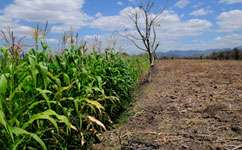Study highlights climate food risk hotspots

The poorest societies may be more able to adapt to the threat climate change poses to food supplies than their slightly richer peers, a new study suggests.
You might assume getting richer would always make a country safer from drought and famine, but that turns out not to be the case. Instead, the very poorest countries seem to become more vulnerable in the early stages of development. There's a crucial period before the benefits of modernisation start to kick in, during which they are more vulnerable to problems like drought than when they started.
'It turns out that the very poor and the relatively wealthy are less vulnerable than the group in the middle,' says Dr Evan Fraser, a researcher specialising in food production and its relation to social and economic conditions who works both in the geography department of the University of Guelph in Canada, and at the School of Earth and Environment at the University of Leeds.
At a broader scale, his research highlights areas that are at particular risk of climate-induced crop failures, including south-eastern South America and the north-eastern Mediterranean.
Fraser suggests the counterintuitive result may be partly because assistance from other nations and NGOs tends to dry up once a country is no longer classed among the very poorest. But it may also be because moving away from traditional farming practices has a cost, and it takes time for new methods to start paying dividends.
For example, switching from pastoral farming to settled agriculture can bring benefits to local people in the long-term, once they can introduce new techniques like higher-yielding, drought-resistant crops and modern machinery. But these need investment to work, and it takes time for poor farmers to build up the necessary capital.
In the meantime, most land has been parcelled up into private plots and is now crisscrossed by fences, so people can no longer respond to drought as their pastoralist ancestors would have - by simply moving their herds somewhere with more water.
"There seems to be a dangerous middle ground where the old ways no longer function, but the new ways aren't up and running yet, and people are at their most vulnerable," says Fraser. "Development has damaged traditional agriculture, but they can't yet use capital-based adaptation strategies, from fertilisers and bank loans to higher-yielding breeds of cow."
It's an unexpected result, but it's being found at several different scales and by different teams. Other research by the same group interviewing households in Malawi and Botswana, still in press, reached similar conclusions at a local level.
Fraser thinks policy-makers and NGOs should take the findings into account. "We're finding a real tradeoff between adaptation and development," Fraser notes. "That's not to say we should discourage development, but you can't assume that by promoting it you're also helping people adapt to climate change. It's not that traditional is always better, but as people move from traditional to modern they lose things; policy-makers need to think about how to help them make the transition."
His team devised a two-part process to identify areas that are at particular risk from drought-induced famines over the coming century. First, they used a climate model to predict where rainfall and soil moisture may fall sharply. They then analysed a range of social and economic data to work out how well different countries could adapt to environmental change.
In part this involved looking at the effects of drought on different countries in the past, and trying to work out why some have coped well and others have been pitched into devastating famines. They ended up with a map of how well different areas were likely to be able to cope with future climate change.
Putting the two results together allowed the scientists to calculate where the risk to food supplies is most serious – areas that will suffer severely from climate change and where societies will be least able to adapt.
They focused on wheat and maize production, both because these are two of the most vital crops and because better data is available on them. It turns out that for wheat, the vulnerable spots are the south-eastern USA, south-eastern South America, the north-eastern Mediterranean and parts of central Asia. For maize, the risks seem to be south-eastern South America, the north-eastern Mediterranean and parts of southern Africa.
Fraser notes, though, that the paper's methodology has limitations. For example, some areas may appear very resilient to drought because in the past they've been able to use groundwater to keep crops alive. If aquifers start running dry, areas like the American Midwest could be much more vulnerable to future droughts than this study suggests.
The study is published in two parts. The first part is in the journal Food Security and the second in Agricultural and Forest Meteorology. This work was funded by NERC under the Quantifying and Understanding the Earth System (QUEST) research programme, the Rural Economic and Land Use Program, and the ESRC's Centre for Climate Change Economics and Policy.
Journal information: Agricultural and Forest Meteorology
Provided by PlanetEarth Online
This story is republished courtesy of Planet Earth online, a free, companion website to the award-winning magazine Planet Earth published and funded by the Natural Environment Research Council (NERC).

















